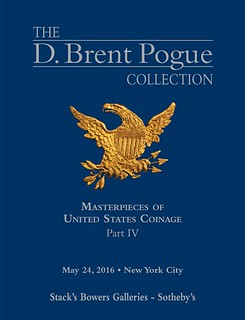
PREV ARTICLE
NEXT ARTICLE
FULL ISSUE
PREV FULL ISSUE
BUILDING THE D. BRENT POGUE COLLECTION
Stack's Bowers Pogue Collection cataloguer John Kraljevich's introduction to Part IV is an insightful overview of the painstaking
and time-consuming effort involved in both forming and documenting such a collection of important, high-quality United States coins.
Here's an excerpt. Elsewhere in this issue are some selected coins from the catalog. -Editor
Nowhere on the pages to follow will there be evidence of the hundreds, perhaps thousands, of auction catalogs that were scanned and set aside after discovering they offered no coin important enough to add to this collection. The hours of phone conversations held with trusted advisors are unrecorded and unmentioned. Trips to dozens of coin shows across the United States, peering in cases and fielding offers from all comers, are not cited within, nor are the years of experience required to discern true gems from fool’s gold. Much of this collection was formed before the era of certification, placing extra importance on the eyes and courage of the purchaser. The expertise and confidence needed to purchase coins in such an environment is implicit here, even as the results of those processes are evident to all. This collection was formed one coin at a time. While a few small groups were acquired en bloc, including the Lawrence Stack Type Set and the Foxfire Collection, most were added as they revealed themselves singly to the marketplace. Such an endeavor requires both patience and quick reflexes, the former enabling a collector to wait for the right coin, the latter allowing them to pounce when it becomes available. The spaces in between acquisitions were full of study, consuming books and catalogs, listening more than speaking when experts were around, and studying far more coins than will ever bear the Pogue provenance. Building a catalog is not entirely unlike forming a collection. For every research reference that is cited, several more proved useful, and dozens of further sources were examined despite yielding little. Experts in every specialty allowed ready access to their knowledge and libraries, typically on a deadline and with nothing in return but gratitude. The brute labor of numismatic research is not a profitable endeavor, but people like Saul Teichman, Craig Sholley, John Dannreuther, P. Scott Rubin, and others harvested facts with a sharpened scythe for years in expectation of no greater return but the joy of discovery and the pleasure of their work proving useful. It has, and to these gentlemen and others, who opened their notebooks, libraries, and memories, I am grateful beyond words. Just as the work of coin buying became a little easier after the dawn of coin certification, so too has the work of numismatic research become less onerous in the age of digitization. Had the extraordinary riches of the Newman Numismatic Portal been available when the first three D. Brent Pogue catalogs were being written, they might each be a pound heavier. Only time limits the amount that can be discovered from the published works and unpublished archives made available by the NNP. Other institutions have also made these travails less trying, including the American Numismatic Society and the American Numismatic Association, whose searchable digital archive of The Numismatist makes membership one of the numismatic community’s greatest bargains.
As a collector myself (on a vastly smaller scale), this description of the effort and patience required rings true, and would be part of
my advice to any serious collector. Homework must be done, and hours of study logged. Luck and resources are valuable, but their rewards
are reaped many times over when combined with knowledge, skill, good advice, and the backbone to invest quickly and strongly when rare
opportunities arise.
As a participant in the creation of the Newman Numismatic Portal I'm glad to see confirmation of its great value for numismatic researchers, which only grows stronger with each additional book or document. -Editor To read the complete article, see:
THE BOOK BAZARREWayne Homren, Editor The Numismatic Bibliomania Society is a non-profit organization promoting numismatic literature. See our web site at coinbooks.org. To submit items for publication in The E-Sylum, write to the Editor at this address: whomren@gmail.com To subscribe go to: https://my.binhost.com/lists/listinfo/esylum All Rights Reserved. NBS Home Page Contact the NBS webmaster 
|
